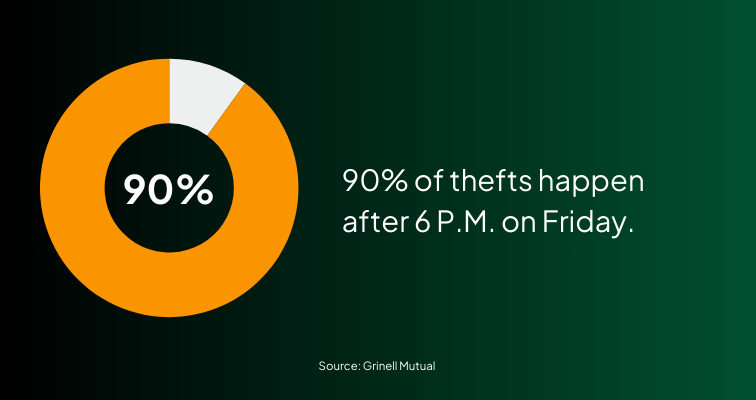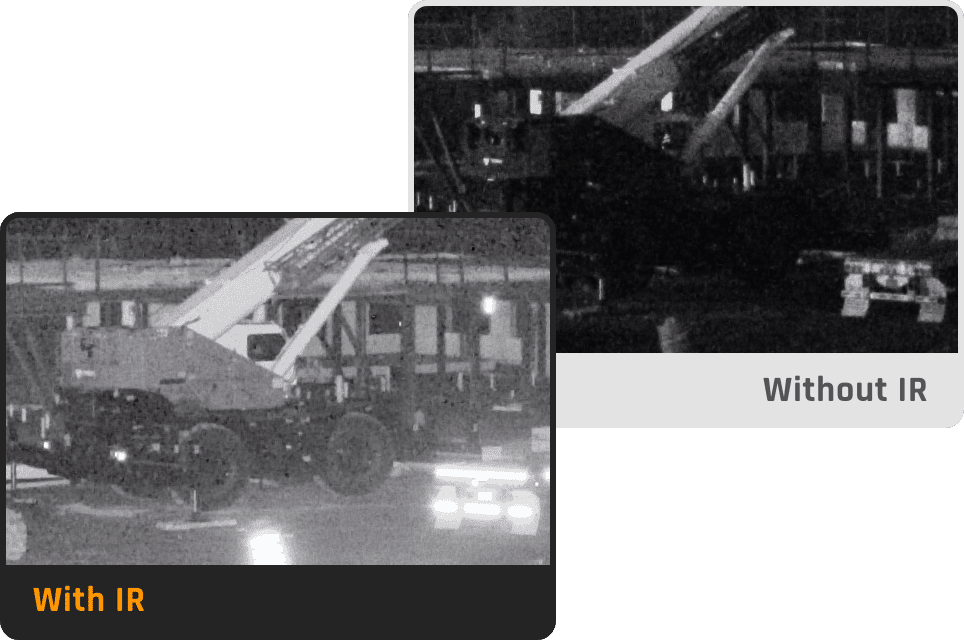It’s no secret that most construction site thefts occur at night, but did you know that a staggering 90% of thefts happen after 6 P.M. on Friday? That’s because thieves and vandals know that darkness is their best friend.

Until now, that is, as night vision cameras give construction site managers and security personnel a leg up, even in low-light conditions. But do construction sites really need night vision? How does that technology even work? And if you wanted to invest in a night vision system, where would you even begin?
If any of those questions popped into your head, then you’re in the right spot. We cover how night vision cameras work and what you can do to maximize their performance, ensuring you have constant eyes on your construction projects, no matter how much you have (or don’t have).
Why Construction Sites Need Night Vision Cameras
Construction cameras give you eyes on your jobsites when you can’t physically be there. Unfortunately, the standard camera will do little good when conditions change and the darkness of night descends.
The darkness is only one reason to think about night vision cameras for your jobsite. The others include:
- The Risks of Poor Visibility: Poor visibility, such as at night, increases the dangers of theft, vandalism, and unauthorized entry. These belligerent activities put your projects at risk, as materials, equipment, and structures that receive damage or go missing create delays.
- How Night Vision Enhances Security: Modern security cameras equipped with infrared technology and low-light sensors capture clear footage even in pitch-black conditions. This low-light imaging technology allows monitoring teams to maintain constant surveillance and respond rapidly during incidents.
- Real-World Use Cases: Night vision security cameras help construction companies identify and prevent theft of materials and equipment while documenting unauthorized personnel. Smart detection features combined with thermal imaging also allow monitoring teams to differentiate between genuine threats and false alarms, significantly improving response times and overall site protection.
Implementing night vision technology in your construction site security is a game-changing investment. When combined with other security measures, like TrueLook’s TrueDeter, these cameras provide the visibility needed for comprehensive site protection during vulnerable nighttime hours.
How Do Night Vision Cameras Work?
Our human eyes can only see a small portion of the electromagnetic spectrum, known as visible light. While most of that spectrum is invisible to our eyes, night-vision cameras use technology to illuminate the darkness.
Scientists have found three primary ways to make night vision possible, and the camera will utilize one (or more) of these methods to deliver an image:
Infrared (IR) Night Vision
IR cameras work by using small LED bulbs that emit infrared light, which reflects off objects. The camera’s image sensor captures the reflected light to produce visible footage. The camera’s IR cut filter switches automatically between daytime image quality and infrared night vision for optimal surveillance in all lighting conditions.

Since infrared light is invisible to the naked eye, IR illumination enables monitoring teams to watch areas without alerting potential intruders. This invisible infrared light lets cameras capture clear footage while maintaining complete discretion.
Thermal Imaging
Everything in the universe emits heat, detectable as infrared energy. Thermal cameras detect infrared energy emitted by objects, creating images based on temperature differences between objects and their surroundings rather than using visible or infrared light. Heat signatures from people, vehicles, and other warm objects stand out against cooler objects in the background, making it impossible for intruders to hide.
Unlike traditional vision cameras that rely on light or IR illumination, thermal imaging works effectively through smoke, fog, and dense vegetation, providing reliable detection in challenging environmental conditions. However, thermal cameras produce significantly lower-quality images than alternative methods.
Low-Light (Starlight) Technology
Low-light sensors utilize image enhancement technology to amplify the smallest amounts of ambient light, including starlight and distant artificial lighting, to produce high-quality color footage in extremely low-light conditions. These advanced sensors can deliver daytime-like image quality even when the human eye perceives near-complete darkness.
Starlight night vision cameras utilize advanced STARVIS sensors but are prone to motion blur because of the longer exposure times. Likewise, these low-light color cameras can be prohibitively expensive for construction companies compared to traditional IR cameras.
How the Technologies Compare
Night vision technologies excel in different scenarios. For example, IR cameras offer affordable round-the-clock security with clear footage in complete darkness using infrared illumination. Thermal cameras provide unmatched obstacle detection by tracking heat signatures rather than light. And low-light (starlight) sensors deliver superior image quality with color reproduction by enhancing ambient light.
Despite their benefits, each has its limitations. IR cameras produce only black-and-white images in darkness and require some IR light to function. Thermal cameras typically offer lower image clarity and are more expensive. Additionally, low-light technology struggles in pitch-black conditions where no ambient light is available.
Key Features to Look for in a Night Vision Camera
Before looking for your next night vision camera, you should have a deep understanding of the key features to ensure you get the right surveillance solution for your needs. Proper camera selection means the difference between capturing clear, actionable footage and missing critical security events.
A professional-grade night-vision camera should have the following features:
- Adequate Night Vision Range: Select a camera with an adequate IR illumination range. Shorter ranges directly impact the camera’s effectiveness. Look for professional-grade cameras that can detect infrared and visible light up to 200 meters in complete darkness.
- High Resolution and Image Quality: Opt for cameras with high-resolution image sensors and robust night vision capabilities. While capturing crystal-clear facial details or license plates at night can be challenging, high-quality images will provide valuable information for security purposes. You’ll be able to get a clear picture of what individuals are wearing, the types of vehicles involved, and identify any equipment that may have been stolen or tampered with.
- A Weatherproof and Durable Design: Outdoor security cameras must maintain image quality and night vision capabilities while withstanding rain, extreme temperatures, and varying lighting conditions throughout the seasons. For construction sites, it’s crucial to choose cameras with even higher durability ratings to protect against dust, debris, and potential impacts. Look for features like an IP67 rating, which indicates complete protection against dust and immersion in water, and consider vandal-resistant housings for added protection.
- The Power of Live Professional Monitoring: While standalone night vision cameras provide valuable surveillance, consider the benefits of adding on live professional monitoring service. This means that trained security personnel are actively monitoring your camera feeds in real-time, ready to respond to any suspicious activity. They can contact authorities, trigger alarms, or even use talk-down features to deter intruders. This proactive approach significantly enhances your security posture and provides peace of mind, knowing your site is protected 24/7.
While high-quality security cameras are essential, they are most effective as part of a comprehensive security strategy. Look for solutions that go beyond just cameras and incorporate additional layers of protection. For example, TrueLook’s TrueShield Security Solution combines powerful IR cameras with strobe lights, sirens, and a talk-down bullhorn to deter intruders and provide immediate intervention capabilities. This multi-layered approach creates a more robust security framework and minimizes vulnerabilities.
How to Maximize the Effectiveness of Night Vision Cameras
To maintain high-quality visuals, even in low-light conditions, you must have proper installation and maintenance. A well-planned camera system provides comprehensive surveillance, but only if you follow some best practices, such as:
- Finding the Optimal Placement: Strategically position your night vision cameras at access points and storage areas to ensure complete coverage. Proper placement will help you avoid interference that could compromise the camera processes and image clarity.
- Select Cameras with Motion Detection Capabilities: Choose night vision cameras with built-in motion detection capabilities. This feature allows the camera to trigger a response when movement is detected, acting as a powerful deterrent against potential intruders. Depending on the system, this response could include activating flashing strobes, loud sirens, or even a talk-down bullhorn to warn off trespassers. This proactive approach to security helps prevent incidents before they escalate and provides immediate protection for your site. For enhanced deterrence, consider solutions like TrueLook’s TrueDeter Security Solution, which combines motion detection with flashing strobes and loud sirens to discourage unauthorized activity.
- Simple Maintenance for Optimal Performance: To ensure your night vision cameras are always working effectively, perform these simple maintenance checks. Regularly inspect the camera lens for any obstructions like dust, pollen, spiderwebs, or snow that might be obscuring the view, especially during seasonal changes.
Also, verify that the camera’s power source is functioning correctly. For electrically powered cameras, ensure there are no tripped circuits or power outages. For solar-powered cameras, monitor battery levels, especially during periods of extended overcast weather. Finally, periodically view the live camera feed remotely to confirm that the image is clear, the night vision is working properly, and there are no connectivity issues.
By following these simple steps, you can ensure your night vision cameras continue to provide reliable security and valuable insights.
Proper implementation of these guidelines helps maintain consistent image enhancement technology performance, ensuring your security system captures critical footage around the clock.
Choosing the Right Night Vision Camera for Your Site
Now that you have a good idea of what owning a night vision construction camera entails, it’s time to look at how to find the right one. You’ll need to consider how you plan to use your setup and what will meet your security needs.
- Assess Site Needs: Evaluate your construction site’s lighting conditions, ambient light levels, and security vulnerabilities to determine how many cameras you need and where to place them.
- Compare Wired vs. Wireless Cameras: Wireless cameras offer flexible installation and remote monitoring capabilities, while wired systems typically provide more reliable recording without connectivity concerns.
- Balancing Budget and Features: If your budget doesn’t allow for a full security system (and your insurance doesn’t require it), prioritize essential capabilities like IR illumination range and image enhancement technology. These features directly impact the camera’s ability to capture clear and usable footage in low-light conditions, which is crucial for effective security monitoring. While features like two-way audio can be valuable for deterrence and communication, they may be considered secondary if budget constraints are a major concern.
Your partnership with a construction camera provider shouldn’t be a headache, either. Don’t forget to ask about customer support availability, documentation access, and professional installation options.
Secure Your Site After Dark with the Right Night Vision Camera
We all would love to deploy a crack team of security professionals wearing night vision goggles to protect our jobsites. Yet, the right night vision security camera is the next best thing. From thermal and infrared vision to the color night vision footage provided by starlight sensors, we now have unique abilities to view our sites after hours.
Ready to invest in an infrared night vision solution that provides unparalleled clarity? Reach out to TrueLook to find the right system for round-the-clock surveillance, even in the dead of night!

